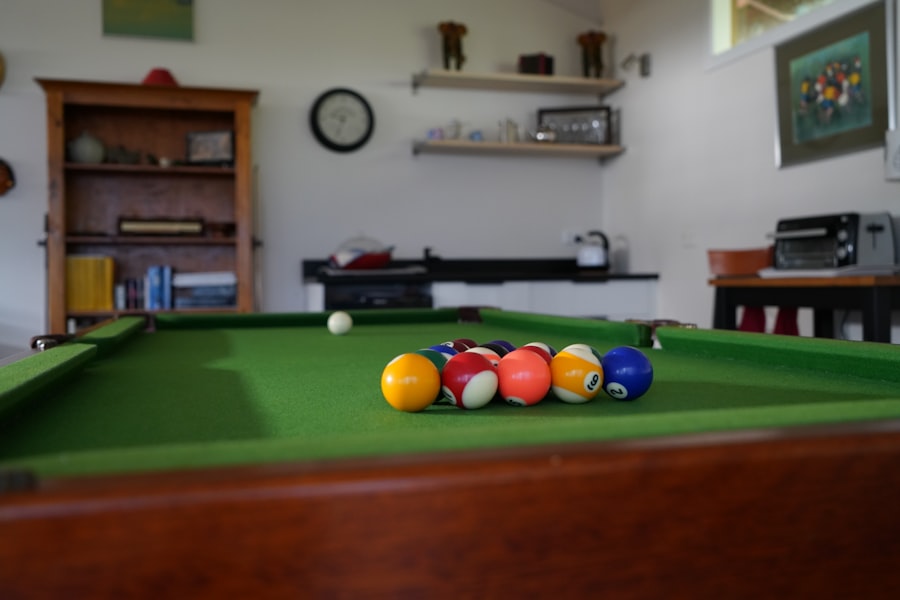Mastering 8 Ball Pool: Tips and Strategies for Success
Description
8 Ball Pool is a classic billiards game that has captivated players for generations. The game is played on a rectangular table with six pockets, using a cue ball and a set of 15 colored balls, which are divided into two groups: solids and stripes. The objective is straightforward: one player must pocket all of their designated balls—either solids or stripes—before sinking the 8 ball to win the game.
The game begins with a break shot, where the player strikes the cue ball to scatter the racked balls, ideally aiming to pocket one or more in the process. The rules of 8 Ball Pool can vary slightly depending on the venue or local customs, but the fundamental principles remain consistent. Players take turns attempting to pocket their balls while adhering to specific rules regarding fouls and turns.
For instance, if a player fails to hit their designated balls first or pockets the cue ball, it results in a foul, giving the opponent an opportunity to take control of the table. Understanding these basic rules is crucial for any aspiring player, as they form the foundation upon which more advanced strategies and techniques are built.
Key Takeaways
- Understanding the basics of 8 Ball Pool is essential for mastering the game
- Developing cue ball control is crucial for precision and accuracy in shots
- Mastering bank shots and carom shots can give you an edge over your opponents
- Learning advanced spin and English techniques can help you manipulate the cue ball for better positioning
- Practicing your break shot is important for gaining an advantage at the start of the game
Developing Your Cue Ball Control
Cue ball control is arguably one of the most critical skills in 8 Ball Pool. Mastering this aspect of the game allows players to dictate the flow of play and set up advantageous positions for subsequent shots. To develop cue ball control, players must first understand how different types of strokes affect the cue ball’s movement.
A well-executed stroke can impart various spins on the cue ball, influencing its trajectory and final resting position after contact with other balls. Practicing drills that focus on cue ball placement can significantly enhance a player’s control. For example, setting up a series of shots where the player must pocket a ball while ensuring the cue ball lands in a specific area of the table can help refine their precision.
Additionally, players should experiment with different types of strokes—such as follow, draw, and side spin—to see how these techniques affect the cue ball’s path. By consistently practicing these drills, players can develop a more intuitive understanding of how to manipulate the cue ball effectively during actual gameplay.
Mastering Bank Shots and Carom Shots

Bank shots and carom shots are advanced techniques that can turn the tide of a game when executed correctly. A bank shot involves bouncing the object ball off one or more cushions before it goes into a pocket, while a carom shot requires the cue ball to strike an object ball and then hit another object ball in succession. Mastering these shots not only expands a player’s arsenal but also enhances their strategic thinking during matches.
To practice bank shots, players should start by identifying angles on the table that allow for successful rebounds. Using a straight edge or even visualizing imaginary lines can help in determining the correct angle needed for the shot. For instance, if a player wants to bank a solid ball into a corner pocket, they should aim for a point on the cushion that will direct the ball toward the pocket at the right angle. Carom shots require similar precision; players must calculate how to strike one object ball so that it subsequently hits another. Practicing these shots in various scenarios will build confidence and improve overall shot-making ability.
Learning Advanced Spin and English Techniques
| Technique | Description | Difficulty Level |
|---|---|---|
| Topspin | A technique used to create forward rotation on the ball, causing it to dip and bounce higher. | Intermediate |
| Backspin | Produces backward rotation on the ball, causing it to float and drop quickly. | Intermediate |
| Sidespin | Creates lateral spin on the ball, causing it to curve in flight. | Intermediate |
| Knuckleball | A technique that minimizes spin, making the ball’s trajectory unpredictable. | Advanced |
| Jump shot | Using a combination of spin and power to make the ball jump unexpectedly. | Advanced |
Spin and English are terms used to describe how players can manipulate the cue ball’s movement through various types of spin applied during a shot. Understanding how to use these techniques effectively can elevate a player’s game significantly. For example, applying topspin (or follow) causes the cue ball to continue moving forward after striking an object ball, while backspin (or draw) makes it reverse direction after contact.
Side spin can alter the angle at which the cue ball travels after hitting an object ball or cushion. To master these advanced techniques, players should engage in targeted practice sessions focusing solely on spin applications. A useful drill involves setting up shots where players must use topspin or backspin to achieve specific outcomes, such as positioning the cue ball for an easy next shot or avoiding obstacles on the table.
Additionally, players should experiment with different amounts of spin to see how it affects their shots. Understanding how to apply English effectively can also open up new strategic possibilities during gameplay, allowing players to navigate complex table layouts with greater ease.
Practicing Your Break Shot
The break shot is one of the most critical moments in an 8 Ball Pool game, as it sets the tone for the entire match. A powerful and well-aimed break can lead to immediate scoring opportunities and put pressure on opponents right from the start. To practice an effective break shot, players should focus on their stance, grip, and stroke mechanics.
A solid foundation is essential for generating power while maintaining accuracy. Players can enhance their break shot by experimenting with different techniques and strategies.
Practicing with different levels of force can also help players find their optimal break style. Additionally, analyzing successful breaks from professional matches can provide valuable insights into effective techniques and strategies that can be adapted for personal use.
Understanding Defensive Play and Safety Shots

Understanding Safety Shots
Safety shots are designed to leave your opponent in a difficult position while maintaining control of the table. These shots can be game-changers in competitive matches, and mastering them is essential for effective defensive play.
Developing Defensive Strategies
To develop effective defensive strategies, players should practice various safety shot techniques. For example, placing an object ball between the opponent’s cue ball and their target ball can create obstacles that make it challenging for them to execute their next shot. Additionally, learning how to hide the cue ball behind other balls or positioning it in less favorable areas of the table can further enhance defensive play.
Incorporating Defensive Play into Your Practice
By incorporating defensive strategies into regular practice sessions, players can become more adept at recognizing when defensive play is necessary and executing it effectively during matches. With consistent practice, you can improve your defensive skills and gain a competitive edge over your opponents.
Improving Your Positional Play and Shot Selection
Positional play refers to how well a player positions their cue ball after each shot to set up subsequent plays effectively. Good positional play is essential for maintaining control over the game and ensuring that each shot leads smoothly into the next one. To improve this skill, players must develop an understanding of angles and trajectories while also considering potential obstacles on the table.
Practicing drills that focus on positional play can help players refine their skills in this area. For instance, setting up scenarios where players must pocket one ball while ensuring that the cue ball lands in an optimal position for their next shot can be beneficial. Additionally, players should learn to visualize potential paths for both their cue ball and object balls after each shot, allowing them to make informed decisions about shot selection based on their desired outcomes.
By honing these skills through consistent practice, players can enhance their overall gameplay and increase their chances of success during matches.
Developing a Winning Mindset and Mental Toughness
A winning mindset is often what separates successful players from those who struggle under pressure. Mental toughness involves maintaining focus, composure, and confidence throughout a match, regardless of external factors such as distractions or setbacks. Developing this mindset requires intentional practice and self-reflection.
One effective way to cultivate mental toughness is through visualization techniques. Players can mentally rehearse successful shots or entire matches before they occur, reinforcing positive outcomes in their minds. Additionally, practicing mindfulness techniques—such as deep breathing or meditation—can help players stay calm and focused during high-pressure situations.
Setting realistic goals for improvement and celebrating small victories along the way can also contribute to building confidence and resilience in competitive environments. By prioritizing mental preparation alongside physical skills, players can enhance their overall performance and increase their chances of achieving success in 8 Ball Pool.
If you enjoy playing mobile games like 8 ball pool, you may also be interested in checking out the latest update for Super Mario Run. The article Super Mario Run 3.0.9 discusses the new features and improvements in the popular game. It’s always fun to explore different gaming options, so why not give Super Mario Run a try alongside your favorite pool game? Who knows, you may discover a new favorite pastime!
FAQs
What is 8 ball pool?
8 ball pool is a popular multiplayer online game where players can compete in virtual pool matches against each other.
How do you play 8 ball pool?
In 8 ball pool, players use a virtual cue stick to hit balls on a virtual pool table, aiming to pocket their designated balls (stripes or solids) and then the 8 ball to win the game.
Is 8 ball pool free to play?
8 ball pool is free to download and play, but it offers in-app purchases for virtual currency and other items.
What platforms can you play 8 ball pool on?
8 ball pool is available to play on mobile devices (iOS and Android) as well as on Facebook.
Can you play 8 ball pool with friends?
Yes, players can connect with friends and challenge them to 8 ball pool matches.
Are there different game modes in 8 ball pool?
Yes, 8 ball pool offers various game modes including 1-on-1 matches, tournaments, and mini-games.
Is 8 ball pool a skill-based game?
Yes, 8 ball pool requires skill, strategy, and precision to win matches, making it a popular choice for competitive gamers.





